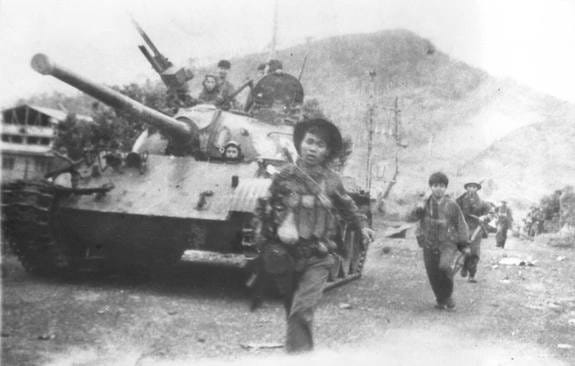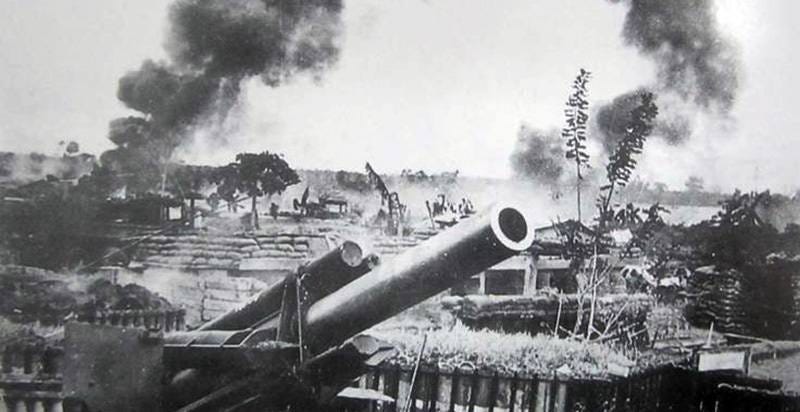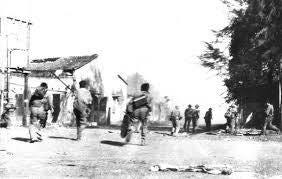The Vietnam War the world knew ended two years before with the 1973 Paris Cease-Fire Agreement. All US troops were gone and POWs returned. South Vietnam was on its own. We were off the front pages. The AP’s Saigon office down to four. All the action was next door in Cambodia with the noose tightening on the capital of Phnom Penh. On paper, South Vietnam had a million-man army and heavily-equipped with American weaponry & aircraft. Cease-fire lines between Saigon government and Viet Cong, now dubbed the Provisional Revolutionary Government (PRG), were eerily holding. But the architect of this fragile peace with promises of help, US President Richard Nixon, resigned in disgrace on 8 August 1974 and replaced by the weak Gerald Ford. Hanoi threw the dice to see what’d come up.
And now that we’re into January 2025 and the 50th Anniversary year of the Fall of South Vietnam, allow me to jump ahead in The Bite of the Lotus: an intimate memoir of the Vietnam War to remember the Battle of Phuoc Long over Christmas 1974 and early 1975 - and the message we missed. By the 30th of April, the war was all over.
Note: Under the terms of the Paris Agreement, the Americans were forced to withdraw its troops but they cheated and renamed MACV (Military Assistance Command Vietnam) the Defense Attaché Office (DAO) of the US Embassy. Provincial Advisory Teams were renamed Consulates and staffed by military advisers now in civilian clothing. Oh, and that wasn’t the only cheating - and by both sides too.
As we welcomed in 1975, a battle was raging up in Phuoc Long Province, along the Cambodian border 130 kms north-east of Saigon, an overlooked region between the southern end of the Central Highlands and the forested uplands that ringed the northern side of the capital. As usual with only South Vietnamese military briefings, details were sketchy, but US sources spoke of a serious pitched battle.
In the first week of January, Phuoc Long’s capital, Phuoc Binh, fell to the NVA – the first to do so since northern Quang Tri during the 1972 Easter Offensive. In that same offensive, the NVA had besieged but had not taken the neighbouring provincial capital of An Loc, 40 kilometres to the south-west, but it held the district town of Loc Ninh, closer to the border, now the PRG’s southern ‘capital’.
It was not fully appreciated at the time, but the Phuoc Long attack was a new development in the war, with the NVA deploying a massive infantry force backed by heavy anti-aircraft guns, long-range artillery and even tanks – quite a surprising development this far south and down the rugged Ho Chi Minh Trail.
By this stage, we heard at war’s end, Hanoi even had an oil pipeline all the way down to Loc Ninh from North Vietnam.
South Vietnamese casualties in the three-week battle were heavy, with the NVA also taking many prisoners. Some ARVN escaped, presumably fleeing towards the friendly lines to the south. But AP Bureau Chief George Esper flew Trinh and me even further north, into the little known and then heavily tribal, or Montagnard, Quang Duc Province. Its capital was Gia Nghia, a good 80 kilometres north-east of Phuoc Long.
As our Air Vietnam DC-4 landed at the red and dusty dirt airstrip, we had no idea where to start looking.
When we dropped in at the local US Consulate, the handful of American advisers were surprised to see us, and sceptical about any escapees arriving in the province. But the next day they lent us a vehicle with a driver and an assistant, who would take us down Route 14 towards Phuoc Long. At an elevation of over 600 metres, the morning air was surprisingly cool as we headed down the deserted road through high savannah country.
After a good 20 kilometres over the rough road, we spotted a small band of South Vietnamese troops coming towards us, and stopped. Most still carried their M-16s, and after staggering up to our vehicle sat down by the roadside, drinking our water and bumming cigarettes. And then came their stories of the NVA’s overwhelming attack on Phuoc Long, and how their Soviet-made T-54 tanks had driven straight down the main street and into the provincial headquarters, the defending ARVNs firing but unable to stop them. Helpless and horrible stuff.
Most of the South Vietnamese were just regional forces, or province-based units, and village militia whose families lived right alongside them. Hundreds were killed along with local civilians. Fearing capture by the encircling NVA from the south, they wisely headed up the old road where we found them. Piling the battle’s survivors into our vehicle, we drove back to Gia Nghia, dropped them off at the military headquarters, returned to the consulate and looked for a way back to Saigon. Luckily, an Air America Pilatus Porter was passing through, and the advisers got us on board.
When my exclusive story appeared later in the Saigon Post, the local English-language newspaper, a large blank space replaced the most vivid descriptions of the battle, especially the troops’ helplessness against those damned NVA tanks. Censored. Those US-supplied anti-tank rockets had bounced right off them.
At the time, we didn’t realise the critical importance of the Battle of Phuoc Long. The South Vietnamese lost 20 aircraft, most to those dreaded Strelas, [Soviet-made SAM-7’s, shoulder-held anti-aircraft rockets] but no major division-level ARVN units, although one crack ranger battalion was decimated on incoming choppers. But we should have recognised the NVA’s masterfully coordinated use of troops, tanks, artillery and anti-aircraft as an ominous sign.
Back in Washington, the Ford administration barely blinked, although the president publicly noted that the North Vietnamese now had nearly 300,000 troops in the South, plus record numbers of artillery, anti-aircraft guns and tanks, and asked Congress for another $500 million in military aid for Saigon and Phnom Penh. But his administration’s failure to retaliate as Nixon had long promised was just what Hanoi wanted. The North Vietnamese now quickly shifted gears for their next crucial move.
[We failed to get the message and two months later, their final offensive began.]
* * *
The Battle of Phuoc Long lasted from 24 December 1974 to 6 January 1975 and in a foretaste of what’s coming throughout this year in Vietnam, Phuoc Long has been throwing quite a party over the past week or so, including a cycling race, mountain climb, opening of a cultural centre and fireworks.
And here, thanks to Luke Johnston whose father served with the Australian Army in South Vietnam, lives in today’s Phuoc Long is how the winning side describes that pivotal battle. Read and follow him at https://www.facebook.com/vinaheritage
50 years ago tonight Mt Bà Rá beside our house was the target of a major assault that really signalled the end of the 'Saigon Republic' four months later.
Text below from a local government website
'In the early morning of December 31, 1974, after the opening artillery barrage, our forces including the 4th Infantry Battalion, the 5th Infantry Battalion (Regiment 165), the 3rd Infantry Battalion (Regiment 141) combined with the Binh Phuoc Provincial Armed Forces from all directions simultaneously opened fire and attacked Phuoc Long sub-region, Phuoc Binh district, Phuoc Binh airport, and Ba Ra Telecommunications Center. On the afternoon of December 31, all of Phuoc Binh's key positions were destroyed. On the night of December 31, we occupied Ba Ra mountain, destroyed and paralyzed the Ba Ra Telecommunications Center. At the same time, the local provincial troops combined with the main force to surround the enemy's targets.
On the morning of January 1, 1975, our two armies from Thac Mo and Phuoc Qua penetrated deeply, attacking the enemy at Suoi Dung and Tu Hien bridges. Other armies attacked strategic hamlets, around enemy posts and defensive posts. The siege of Phuoc Long town was increasingly tightened. We began to open fire and attack Phuoc Long town, destroying each enemy target. The enemy troops fled to the southern gateway of the town to consolidate the Cay Da defense line north of Suoi Dung bridge. We continued to pursue and cross Suoi Dung bridge, the enemy relied on the Cay Da defense line to fight back fiercely. On January 3, we broke through the defense line, raided the town center. The battle took place fiercely in every house and street corner. On the morning of January 6, Regiment 2 (Division 9), a reinforcement force dispatched from the outskirts of Saigon, quickly launched an attack from the South, coordinating with the fighting force to create two pincers to destroy the remaining enemy forces in Phuoc Long sub-region. By noon on January 6, 1975, the victory flag was flying on the roof of the Phuoc Long Provincial Governor's Palace; at 7:00 p.m. on January 6, Phuoc Long was completely liberated.
After 26 days and nights of continuous fighting, the main force troops, along with the army and people of Binh Phuoc, completely destroyed the strongholds of Bu Dang, Dong Xoai, Phuoc Binh, Bu Na stronghold, Ba Ra high point and Phuoc Long town.'






